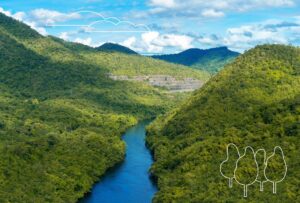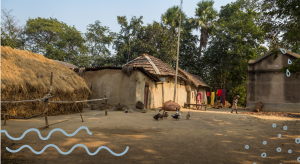Malin Falkenmark on Water’s Hidden Roles and Functions
The past lack of understanding of water’s role for all life on Earth is putting future generations at risk, writes Professor Malin Falkenmark in this article from WaterFront Magazine. Together with Professor Johan Rockström and researcher Lan Wang-Erlandsson, she has published an article in the Journal of Hydrology X described water’s stabilizing role on the life support system in the Anthropocene era.

Since the Mar del Plata Water Conference, the water expertise has been paying most attention to the liquid, blue water, while its role not only in terrestrial ecology but also in stabilizing the Planet’s life support system has remained a blindspot. First of all, the only water that plants can take up to support their biomass production is in fact the green water in the soil. Therefore, in the current era of beginning climate change and sharpening, more intensive droughts, continued population growth in vast dry climate regions, and continued socio-economic development, there is an urgent need to better understand the global water system, and possible limitations in its ability to support the human endeavours. As a first step, the overall Planetary Water Boundary, defined in 2009, is currently developed in terms of five different sub-boundaries.
The many stabilizing roles of water in the water cycle, are now being increasingly clarified: water is first of all acting in three central roles (Rockström et al 2014). In a control role, it has a multitude of stabilizing functions, upholding biomass growth and biodiversity; as victim it is being impacted by land-use activities and water pollution; and in its role as agent, it is generating the fundamental task of moisture feedback from land to atmosphere.
In the recent paper Water resilience for human prosperity (Falkenmark et al 2019), eight core water functions are identified in water’s interaction with the land system through which it passes, which contribute to the stabilization of the life support system. Three water functions are green: generation of air moisture with a greenhouse gas function, that keeps the planet 30 centigrades warmer than without H20; biomass production; and moisture feedback to the atmosphere. Altogether, up to 170 per cent the precipitation over land is involved in these green water functions.
The blue water functions are altogether five, but together involve less than 100 per cent of land precipitation; they involve serving society with water supply; carrier of nutrients and waste; aquatic storages; production; and aquatic biomass growth. Together, these water flows, roles and functions form a densely bundled network with its surroundings, giving life to ecosystems with their ability to support human activities.
Witnessed ecosystem collapses
Humans, however, by their activities, alter the water partitioning in the water cycle, disturbing the core water functions, and degrading the ecosystems and their ability to withstand and recover from shocks. Over time, severe ecosystem disturbances have been generated in both water systems, land use systems and climate-related systems. Degraded green-water dominated ecosystems include desertification, savannization and salinization, while blue-water dominated phenomena include basin closure, aquifer depletion, eutrophication and aquatic system collapses.
History shows that regional scale ecosystem degradation may sometimes even shake societies. Thus, water scarcity and severe water quality deterioration have contributed to the decline of ancient empires, like the Maya empire (800-900 AD), and the Antique Arabian civilization (800 – 1300 AD). More recent collapses of food system, after prolonged droughts, have been contributing to escalating human conflict and national instability both through the Arab spring and the Syrian war.
Future outlook
Thus, water with its enormous diversity, is a core component of the Planet’s life support system, and has, with its roles and functions, been essential in stabilizing the system over time. It will therefore be crucial for continuing this stabilization of human livelihood. As in the past, human interference in all these essential water functions, green as well as blue, will of course continue to modify the system, challenging the ability of the coming generation to find out how to keep the system stabilized.
A central question for the next generation will be how further future stresses, caused by the ongoing climate change, population growth, and increasing human demands will continue to disturb the life support system. Will its stabilizing ability, in other words the water resilience-based interactions between water flows, functions and roles, on the one hand, and core ecological processes, like production of oxygen, food, timber, energy, and biodiversity, on the other, be able to keep the system in balance? And what risks will be involved? In view of the strong driving forces in the Anthropocene, the complex interactions with social-economic phenomena will evidently need special attention.
Hydrological lens remains at the center of human life support
Furthermore, the most visible manifestation of climate change will be displayed through the hydrological lens – in the form of e.g., floods, droughts, sea-level rise, etc. – and may trigger an understudied interplay of ecological, biophysical and social feedbacks. At the same time, uncertainty is an important component in current predictions of Earth’s future climate, associated with clouds, i.e. the water in the sky, and the dynamics of biosphere carbon feedbacks, related directly to water cycle resilience. Thus, the role of water for future Earth system resilience will be essential to clarify further.
The critical question to focus on will be what shifts will be needed to keep the planet in the present favourable Holocene-like conditions with relatively stable climate, by safe navigation of the life support system: What transformations will be needed? What changes in governance approaches in terms of scope, scale, and speed will be required? HOW can that be done?
Stockholm WaterFront, no 1 2019
Sign up for your FREE subscription of Stockholm WaterFront here >>








